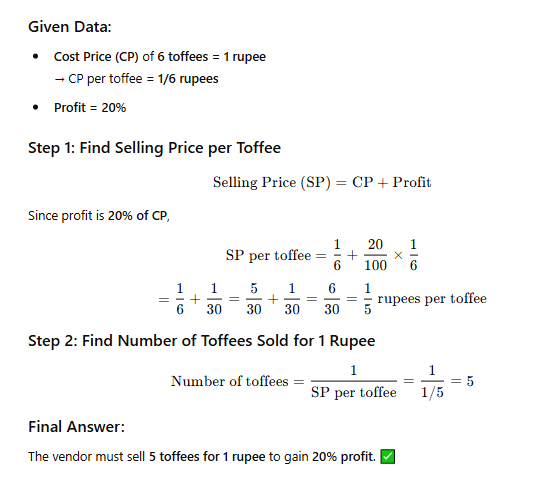A vendor bought toffees at 6 for a rupee. How many for a rupee must he sell to gain 20%?

Let’s start by understanding what we know: The vendor buys 6 toffees for 1 rupee. This means that each toffee costs 1/6 of a rupee.
To find out how many toffees he should sell for a rupee to make a 20% profit, we need to:
- Calculate the cost of each toffee
- Add 20% to get the selling price
- Convert this into toffees per rupee
Let’s calculate: Cost per toffee = 1/6 rupee
To make a 20% profit, the selling price should be: Selling price = Cost + 20% of Cost Selling price = Cost × (1 + 20/100) Selling price = Cost × 1.2 Selling price per toffee = (1/6) × 1.2 Selling price per toffee = 1/5 rupee
Now, if each toffee sells for 1/5 of a rupee, then for one rupee, the vendor should sell: Number of toffees = 1 ÷ (1/5) = 5 toffees
Therefore, the vendor must sell 5 toffees for a rupee to gain a 20% profit.
To verify this makes sense:
- Cost of 5 toffees = 5 × (1/6) = 5/6 rupee
- Selling price = 1 rupee
- Profit = 1 – 5/6 = 1/6 rupee
- Profit percentage = (1/6 ÷ 5/6) × 100 = 20%
This problem illustrates an important principle in retail pricing: when you want to achieve a certain profit margin, you need to adjust your selling quantity accordingly. The vendor started with buying 6 toffees for a rupee but needs to sell 5 toffees for a rupee to make his desired profit. This reduction in quantity for the same price allows him to cover his costs and make his target profit margin.
